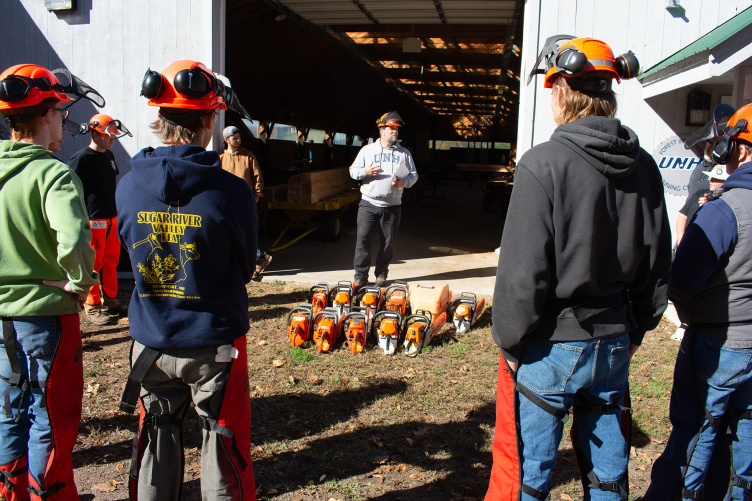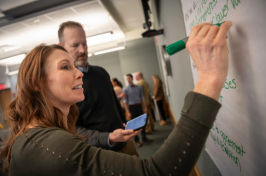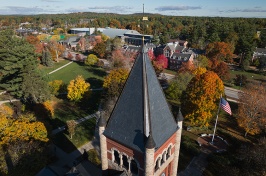
The harvesting and processing of forest products is not just one of New Hampshire’s oldest and largest industries, it’s also one of the state’s most adaptable. The forest industry started in the 17th century to feed the British crown’s insatiable appetite for ship masts, and it stays current by providing high-tech building materials and biomass energy.
Yes, the local forest industry has proved remarkably nimble for its age. Its latest pivot, choreographed with help from UNH Extension, is aimed not at evolving product demand but a changing labor supply. Starting in 2025, there’s now an entry-level credential sponsored by the Granite State Division of the Society of American Foresters, that serves as an on-ramp into a career in forestry — including additional education, certification, and licensure.
Traditionally, people found their way into the industry through informal networks, says Jasen Stock, president of the New Hampshire Timber Owners Association (NHTOA).
“The path that we have seen in the past is you learned, usually through a family member or a friend in the family, or living in a community where there are foresters or land managers in the community,” says Stock. If logging, trucking or sawyering wasn’t the family business, there was probably a neighbor who could show someone the ropes.
But the traditional path hasn’t been providing enough new talent. Lindsay Watkins, a forestry field specialist for Extension, says she hears about it from employers, and sees it at industry events. While the field is becoming more diverse, “it’s an aging workforce, still predominantly male, predominantly people that grew up in the New Hampshire woods; even then it’s not something that a lot of youth are finding their way into,” Watkins said.
$1.6B Industry
The forest products industry, a term that describes logging as well as the myriad products made from felled trees, is one of the state’s most productive economic activities. The industry directly generates $1.6 billion and employs more than 7,200 people.
The likelihood of knowing someone who works in the woods is lower now, Stock says, due to industry consolidation. Without a pathway accessible to them, it’s hardly any wonder that few young people consider a career in forestry.
But would they consider such a career, if a path were cleared for them? It seems that the answer is a strong yes, based on the response to forest career expos, led by the NHTOA and co-sponsored by UNH. These events brought lots of private industry and other employers together to showcase work opportunities in New Hampshire’s great outdoors for curious young people. Attendance was stronger than expected and has only grown, with an expo held in the North Country’s Lancaster Fairgrounds last fall drawing 1,200 students from several high schools .
“That’s just amazing,” says Andy Fast, state forestry specialist for UNH Extension. Yet the success also exposed a problem — there was no apparent next step for the students who attended one of those expos and liked what they saw.
Breaking a New Trail
It took the collaboration of several partners to make the career expos successful, Fast says, and those partners also saw the need to break more trail so that the next generation could follow behind them.
Starting in the fall of 2025, high school students or adults interested in a career change can pursue an industry-recognized credential (IRC) program endorsed by the state’s primary forestry association, the Granite State Division of the Society of American Foresters (SAF), and developed by UNH Extension, NHTOA, NH Division of Forests and Lands, and with support from the Conservation Fund. The program consists of several online learning modules followed by a day of classes at UNH and finally a day of field learning with an industry partners.
Once in hand, the certification could be used to gain a competitive edge for an entry-level opening, or it could be used as a springboard toward further study, such as for the SAF’s forestry technician certification or by enrolling at UNH as a member of the forestry program offered by the College of Life Sciences and Agriculture.
“This is that next step,” Fast says, noting that this effort is a model for similar initatives and programs across the country. It is a true New Hampshire innovation. “It’s sort of nice that we led the way and have been the pilot for that, and at least currently look like we’re having a lot of success.”
As with the expos, the IRC program has tapped into a vigorous vein. The first cohort filled to capacity and a second cohort and third cohort, planned for the spring of 2026, is also projected to be full. Fast said a summer cohort could be added if demand sustains.
Forestry’s Next Generation
Matthias Nevins, chair of the SAF’s Granite State Division, is optimistic about what the IRC program will mean for the future of the state’s storied forestry industry. He noted that he grew up in New Hampshire, his parents even had a relationship with a logger, and even so, he said he had “no idea” as a high schooler that he could make his living in the woods.
“That was never a path that was presented to me, or if it was I wasn’t perceptive of it,” Nevins said. The students who go through this program, though, will know better than he did. “If a few of those kids go into the industry or get closer to it, that’s positive.”
Watkins, who found her way to forestry despite growing up in suburbia, says that some people are just more at home in the woods than they are in a cubicle. She explains that the forest industry is “a great way to spend time outside, being in beautiful places. There’s more variety and opportunity than people realize.” Some forestry jobs involve a lot of interpersonal work, while other people have only trees as co-workers. And technology continues to change how people in the woods do their work.
“There is research out there that shows that being in a natural, green space is beneficial to our mental health,” says Watkins. “There’s more to life than learning how to prompt AI.”
-
Written By:
Adam Drapcho '05 | UNH Extension | Adam.Drapcho@unh.edu
















































